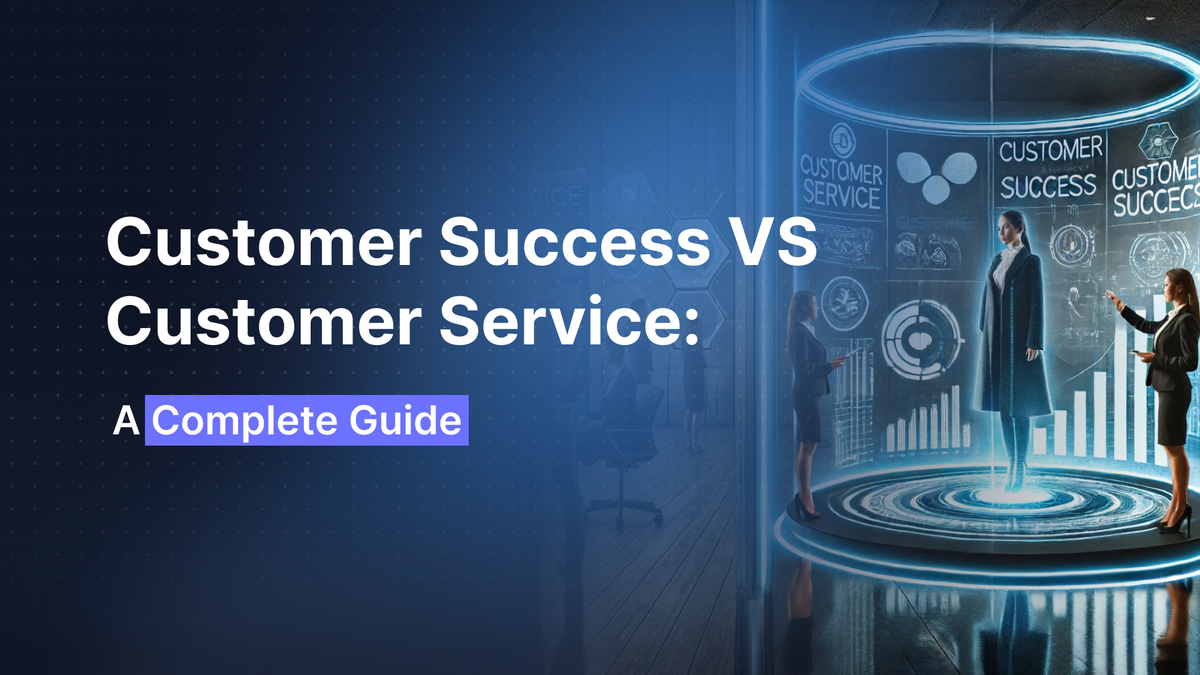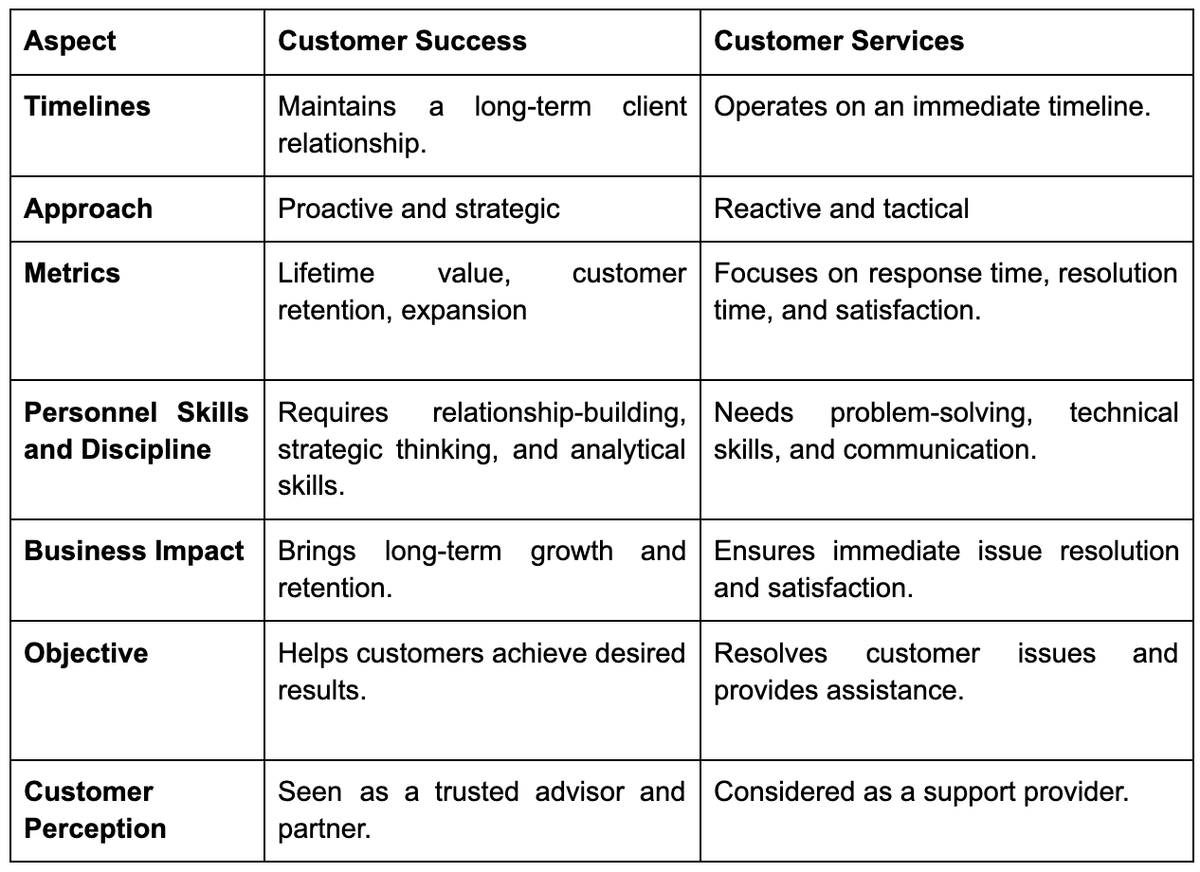Understanding the difference between customer success and customer service ca...

If there is one thing that matters the most in the business world, it is customer relationships. For maintaining these relationships, customer success vs customer service play an important role. Understanding these concepts is integral to business growth and creating a next-level customer experience.
When reading these two concepts, it’s natural to get confused and end up with the question, is customer success the same as customer service?
Customer success easily overlaps with customer service, but they are two separate initiatives, each having its own importance. While it’s easier to understand customer success vs customer service on their own, it’s equally important to know what they are not, or how they differ.
So, let’s shed light on the difference between these two concepts.
Customer success is an effort from the business’s side that utilizes different products and services to help its customers achieve their objectives. It is about anticipating the challenges that a customer may face and then proactively providing the solutions and answers. This aspect of client management is focused on aligning the customers with a company’s goals to get beneficial outcomes for everyone.
However, with the increasing competition in the market, it’s no longer sufficient to assume that traditional company operations will be able to tackle customer success. A whole dedicated team working proactively should assist customers in using the product.
It’s now clear what client success is, but why is it important? The company’s success is connected to the customer's success. If customers use the product and find it beneficial, there’s a high chance that they will engage with and promote your product.
Even more, customer success translates to higher retention rates, and increasing customer retention by 5% results in increased profits by 25% to 95%. Since you boost customer happiness, they are more likely to stay and increase your revenue.
Today, growing businesses understand how important customer success is for their growth. They use effective customer success strategies to ensure customer retention. While the strategies may vary, the goals for customer success remain the same for every business.
The key is to adapt to the changing customer needs and make smart decisions for your business. An effective customer success strategy focuses on providing more value to customers out of their purchase, which is important to ensure a successful path into the future.
Customer service is the support you provide to your customers both before and after the purchase. Its goal is to ensure your customers have an easy and enjoyable experience with your company. Customer service is essential to ensuring customer retention and growing your business. With so many companies offering similar products and services in the market, it is customer service that makes your brand stand out among the rest.
Customer service, as commonly believed, is not just about answering questions. It also includes:
Customer services are focused more on short-term transactions compared to long-term relationships in customer success. Customer service staff troubleshoot technical issues that customers may face and resolve any pricing disputes.
Customer service is essentially centered around ensuring a positive customer experience and supporting the business objectives. The primary goals of customer service look like:
The end goal is always making a customer happy, but how is this “happy” different from the one we ensure in customer service? Let’s understand this by going through the difference between customer success and customer service.
After defining customer success and customer service, it’s clear that these two concepts are not the same. Customer service is just the first step, and seeing a happy customer makes us believe we have achieved the goal, but it’s meaningless as long as there’s no customer success.
Confused? Let us see customer success vs customer service in more detail to understand it better.
The timelines in which customer success and customer service operate vary significantly. It is also the key difference that helps set apart these two concepts.
Customer success is ongoing and focuses on continuous engagement with customers and maintaining a long-term client relationship. It is about anticipating the future needs of the customers, so staff working for customer success usually have a long-term relationship with the clients.
Customer service is the opposite; it is short-term and operates on an immediate timeline. It is about addressing customer issues and inquiries as they arise. This is done to improve their immediate experience and increase the reputation of the brand. Customer service employees usually have brief interactions with clients over various mediums, like chat, calls, messages, etc.
Customer success involves proactive engagement to ensure long-term satisfaction. It requires a strategic and anticipatory approach that focuses on understanding and helping customers achieve their goals. It involves the actions that a company takes to prevent any issues that may arise. Customer-success-oriented businesses emphasize building long-term relationships and driving success through value and continuous support.
On the other hand, customer service is more reactive and only comes into play when addressing customer issues and inquiries. The focus is completely on resolving immediate concerns and engaging with them at the point of sale.
Customer success and customer service are measured through different metrics.
For customer success, there are long-term indicators. The metrics are typically related to business impact. These metrics assess how effectively the company is ensuring customer growth and overall satisfaction. Some factors include:
The customer service metrics measure the quality of customer service. It is centered around immediate performance indicators that assess the efficiency of the service. It includes:
Though customer success and customer service professionals have some overlapping skills, they have divergent skill sets when it comes to planning. Both these roles require employees to have a good understanding of customers, to be empathetic, and to be capable of solving problems.
Customer success staff should specifically be equipped with an understanding of long-term growth along with industry and customer service expertise.
Customer service, on the other hand, requires strong communication skills, conflict resolution, technical skills, and problem-solving abilities for short-term issues.
Customer success is only a value-added component and is not integral to business operations. It has a long-term business impact as it increases customer retention and encourages observing and cross-selling opportunities. Overall, customer success helps in business expansion.
On the other hand, customer service is an integral component of running a business. Effective customer service can maintain customer trust and may result in long-term loyalty.
The goal of customer success is to achieve the desired business outcomes and obtain the maximum value from the product or service over the long term. Customer success essentially requires a strategic and proactive approach to retaining customers.
While, the objective of customer service is to provide immediate support and timely assistance to the customers. It includes troubleshooting problems, answering questions, and ensuring quick resolution to enhance customer satisfaction in the short term.
An organization's initial approach to customer issues significantly impacts customer perception of their brand.
Good customer service helps build a customer's perception of the brand in the beginning. It determines whether the customer feels confident after the first purchase. Customer service, on the other hand, helps build a lasting relationship with customers by helping them proactively.
For example, a follow-up email offering value or some information after the customer purchase is part of a customer success strategy.

Now that you understand the difference between customer success vs customer service, you can use and incorporate both these strategies to help your business grow. While these concepts are different, they are essential for a good customer experience.
Implement the following best practices for customer success and service to see your business thrive.
Customer success representatives should keep the following points in mind:
A good customer experience comes from an easy onboarding process. Having a streamlined process allows customers to quickly understand the use of a product or service. This way customers begin to derive value more effectively from your products, hence increasing their incentive for continued use.
A good trick is to automate the onboarding process and provide AI Chatbot customer service to provide real-time, personalized assistance.
Collecting feedback from customers can measure the performance of a customer success strategy. This can be done in the form of a survey, which can be quantified using the Net Promoter Score (NPS) system. Such feedback helps businesses understand customers' needs and wants. With this understanding, they can develop and deliver products that meet customers’ expectations.
The customer journey maps the different phases that a customer goes through. It includes the time a customer hears about the product, buys, uses, maintains, and renews it. Understanding this journey is important to identify pain points and opportunities for improvement. This insight can be used to develop engagement strategies and more personalized support that would help bring better customer success outcomes.
The following points prove beneficial in customer service success:
To maintain effective customer service, the representatives should maintain good communication that involves responsiveness, empathy and clarity. This includes listening attentively to the customers' needs and coming up with accurate and helpful information. To help prevent misunderstandings, maintain a friendly tone with the customers across all communication channels, whether it's email, phone, chat, or social media,
According to research, about 70% of customers like to solve their customer service issues on their own. This is why providing a self-service option is great for keeping your customers happy. This may include comprehensive FAQs, knowledge bases, video tutorials, and how-to guides available on the company's website. The search functions help customers find answers quickly and get instant access to solutions.
It’s always a great idea to add a touch of personalization to make your customers feel they are a priority. This enhances customer experience and goes a long way toward achieving a good first impression. Remember their name and use it throughout the conversation. Do not rush through the conversation. Give them options and make them feel valued.
It’s clear that customer success vs customer service are two different concepts with different objectives, with a few overlapping concepts. However, for a successful customer experience, it’s essential to ensure that they complement each other and are empowered to do their jobs.
The best part is that most of the aspects of customer service and success can now be automated using AI Chatbots that provide AI Customer service. If your brand is also looking to up the customer experience game, look no further than Aidbase. We understand your brand needs and build chatbots to customize according to your brand’s objectives.